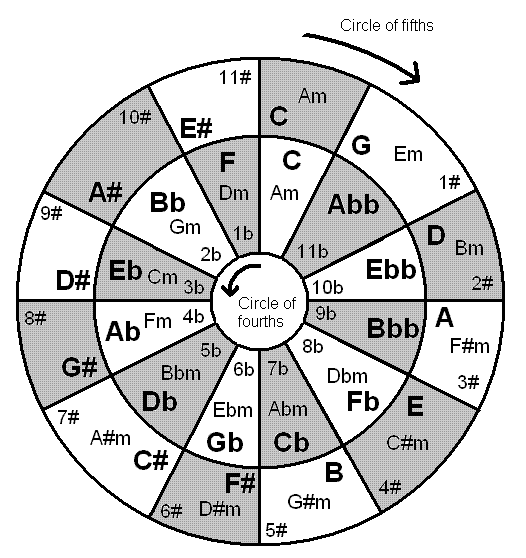Rules to remember:
1. Every major key contains one of each of the seven letter
names used in music. So, when working out the notes of any
key, always start with the musical alphabet.
2. The purpose of applying a key signature is to arrange
the notes so that the major scale formula is maintained. This
formula defines the intervals between each step on the major
scale.
In English terms:
Tone Tone Semitone Tone Tone Tone Semitone
In American terms:
Whole step Whole step Half step Whole step Whole step Whole
step Half step
3. A great way to learn key signatures is to follow the
circle of fifths (for key signatures
using sharps (#s)) or circle of fourths
(for those using flats (bs)).
4. For every major key there is a relative minor key that
shares the same key signature. The relative minor key starts
on the Sixth note of its relative major scale.

How to get really good at working out key signatures:
Working out keys from standard notation:
First read the section on the circle
of fifths to get an understanding of the background. Then
learn these two rules off by heart:
1. For # key signatures the order of sharps is given by the
mnemonic:
Father Charles Goes
Down And Enters
Battle
2. The new sharp in each key is always note seven
Example 1:

1. Count the sharps using the mnemonic from rule 1:
Father Charles Goes
Down
So, even if you don’t read music you know that the
last sharp in the key signature is D#. From rule 2. we know
that this is the 7th note in the key.
If D# is note 7 then the eighth note must be E which means
this is the key signature for E major (or its relative minor
based on the sixth step of the scale – C# minor).
Example 2:

1. Count the sharps using the mnemonic from rule 1:
Father Charles
So the last sharp in the key signature is C#. From rule
2. we know that this is the 7th note in the key.
If C# is note 7 then the eighth note must be D which means
this is the key signature for D major (or its relative minor
based on the sixth step of the scale – B minor).
Now read the section on the circle of
fourths. Then learn these two rules off by heart:
1. For flat (b) key signatures the order of sharps is given
by the mnemonic:
Battle Ends And
Down Goes Charles’
Father
2. The new flat in each key is always note four
Example 3:

2. Count the flats using the mnemonic from rule 1:
Battle Ends And
Down Goes Charles’
Father
So, even if you don’t read music you know that the
last flat in the key signature is Fb. From rule 2. we know
that the key is given by the previous flat in the sequence:
C flat.

So flat keys are even easier to work out than sharp keys
(although most people find it quite hard to get their heads
around how this works. The solution is to work through several
examples yourself until it clicks.)
Working out key signatures on paper:
Example 1: Key of A major
1. Write out the letters from A to A:
A B C D E F G A
2. Decide whether this is a sharp key or flat key. (Clue:
apart from F major all flat keys are built on Flat notes
(Bb, Eb, Ab, etc..). So A is a sharp key.
3. Apply the mnemonic to sharpen the notes until you come
to the 7th note:
Father
A B C D E F#
G A
Charles
A B C# D E
F# G A
Goes
A B C# D E F# G#
A
And stop!
4. So A major has 3 sharps: F#, C# and G#
Example 2: Key of Ab major
1. Write out the letters from A to A:
A B C D E F G A
2. Decide whether this is a sharp key or flat key. (Clue
apart from F major all flat keys are built on Flat notes
(Bb, Eb, A, etc..). So Ab is a flat key.
3. Apply the mnemonic to flat the notes until you come
to the key note and then go one step further:
Battle
A Bb C D E
F G A
Ends
A Bb C D Eb
F G A
And
Ab Bb
C D Eb F G Ab
(Ab is the key note so go one step further)
Down
Ab Bb C Db
Eb F G Ab
4. So Ab major has 4 flats: Bb Eb
Ab and Db
|







